Are you guilty of obsessing over lead generation – so much so that it may have crept into your dreams once or twice? While dreaming about work is less than ideal, you certainly have reason to obsess. Promising leads are the lifeline that keep businesses growing.
However, nurturing those leads can be cause for even more emphasis. Generating leads is one thing, but nurturing them is how your brand can build meaningful relationships and long-lasting customers.
With this ultimate guide, you and email nurturing are about to go from acquaintances to friends to family. Time to get up close and personal:
What is lead nurturing?
You made a good impression and the odds may just be ready to fall in your favor. However, the results won’t be as rewarding with a hands-off, wait-and-see strategy. There’s still some work to do on your end.
With that said, lead nurturing is the process of building relationships with your customers throughout the sales funnel, making a lasting impression at every step of the buyer’s journey. When you rack up all those glowing impressions, those customers will be more likely to think of your brand at the final stages of their decision-making process.
With a lead nurturing strategy in place, marketers can educate prospects, build awareness, develop trust and turn far more leads into valuable customers. That involves listening carefully to the audience, tailoring the content specifically to their needs, preferences and burning curiosities.
Remember – no one wants a forced relationship. Lead nurturing isn’t about throwing a sales pitch their way once a week. It’s about providing the helpful information they want.
What happens when we add email to the mix?
Great things come to those who utilize email lead nurturing. Email is easy to personalize, allowing you to segment your content based on personas and buyer demographics. It’s also easy to measure, which means you can make strategic decisions about how to nurture your leads based on how they interact with the emails they’ve already received.
Take email drip campaigns for example. Your prospects receive emails based on the actions they take – often earning them the influential title of “qualified leads.” Drip campaign tactics make both the initial and follow-up emails relevant to the receiver, eliminating the impersonal nature of email blasts filling already overfilled inboxes.

Wait – is this the same thing as account-based marketing?
Not quite. While both do focus on targeting the highest quality leads with relevant, personalized content, their methodologies are slightly different.
Email nurturing revolves around individual buyers, while account-based marketing targets an entire account or company – or at least all of the major decision-makers at that organization. They also disagree on tactics: Email nurturing utilizes inbound marketing methods to reach prospects, while account-based marketing employs outbound channels.
Account-based approaches work well when you’re targeting a small audience of companies, making it lucrative to target sales approaches to each organization. The inbound marketing approach of email serves marketers well when they intend to reach large, diverse groups of people.

In some instances, the two actually get along well together. Account-based marketing can take the driver’s seat during lead generation, and inbound marketing tactics like email nurturing can then enter the scene to build relationships with prospects and eventually close the deal.
What’s in it for you?
While email lead nurturing does require a concerted effort, the outcome makes it well worth your time. Email often secures more qualified leads, increases conversion rates, shortens the sales cycle and decreases costs per lead – all of which is music to every marketer’s ears.
With lead nurturing campaigns in place, more leads get the attention they need to encourage leveling up to prospects and ultimately customers. Like most inbound marketing strategies, email nurturing focuses on the audience first. That means it’s privy to the whims of moods, trends and interests. As such, continued monitoring and data collection allows marketers to alter their lead nurturing strategies to fall in line with these changes.
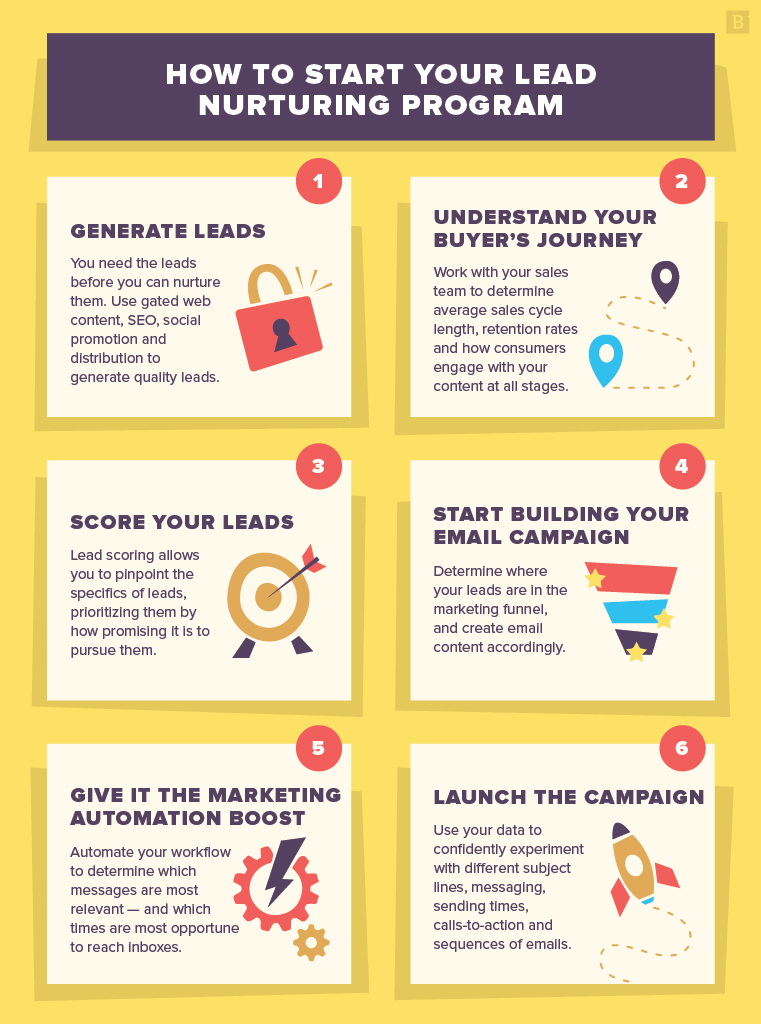
How does one start email nurturing?
Now that we’re well-acquainted, it’s time to cross over into the friend zone and determine how nurturing fits into your inbound marketing strategy. Let’s work our way through the steps:
Step 1: Generate leads
Bear with us while we assume the Captain Obvious role briefly: You need the leads before you can nurture them.
Seriously, though, there’s no nurturing without lead generation. While obvious, it’s an important step that can’t be left out of the process. The stronger your buyer personas and customer segmentation, the better collection of leads you’ll have to work with when it’s time to start nurturing.
This is where tactics like email prospecting may come out to play, utilizing your list of leads to send direct email content. At that point it’s somewhat a shot in the dark – but if recipients open the email and take action, they’re great candidates for becoming prospects.
From there, lead nurturing finds its priceless place in the sales cycle: the follow-up process.
Step 2: Understand your buyer’s journey
What does the road to choosing your brand look like for your customers? You’ll want to understand this path so you can nurture your leads effectively at each stage of the buyer’s journey.
Work with your sales team to determine the average sales cycle length and retention rates, plus how consumers engage with your content from awareness through to conversion. You can use this data to score your leads based on where they are in the decision-making process and align your email campaign at each stage.
Step 3: Score your leads
Now you have a more defined list of leads and a map of the buyer’s journey, but there are more details to uncover. Lead scoring allows you to pinpoint the specifics of leads, prioritizing them by how promising it is to pursue them. This process further helps marketers identify when and how to personalize their email campaigns to each lead.
There are three essential elements to consider when scoring leads:
1. Fit
This data helps marketers determine if the lead fits the characteristics of their buyer personas. Lead fit covers:
- Demographics: includes job title, professional experience, location and salary.
- Firmographics: covers company details, such as size, location and revenue.
- Budget: determines whether the lead can afford your product or service.
- Authority: identifies if they’re a key decision-maker at their company.
- Need: addresses the needs they have for your product and service.
- Time: highlights when they plan to make their decision.
Most marketers gather this information via forms, email subscriptions and online research.
2. Interest and behavior
While they may be a good fit, the leads you want to target are the ones who check all the persona boxes and are interested in your brand. Actions speak louder than words – meaning you’ll want to track email and website analytics as well as social media engagement. These online behaviors may include:
- Open and click-through rates for email.
- Blog engagement (comments, shares, links, etc.).
- Webinar registrations.
- Content downloads.
- Branded keyword searches.
Group the results by the behaviors that indicate engagement versus buying intent. For instance, visiting web pages and attending webinars doesn’t indicate as much buying interest as time spent on pricing pages or watching product demos. You can assign numerical values to the behaviors you choose to track, which allows you to rank leads by their interest in your brand.
3. Buying stage
At this point, you’ll want to identify where buyers are within your sales model. You can use the same numbering system, scoring leads by their standing at either the top, middle or bottom of the sales funnel.
Once you have scores for lead fit, interest and behavior, you can assign a total value to each lead. From there, determine a minimum score that indicates sales-ready leads. Remember that even if they don’t hit that minimum number, you may not want to kick those leads to the curb immediately. Further nurturing can at the very least prompt them to speak highly of your brand to other prospects within their inner circle, even if they don’t become a buyer themselves.
Email nurturing is all about customizing your efforts to better reach potential buyers. That means your lead-scoring strategy deserves some personalization as well. Feel free to tweak the details, tailoring them to what you already know so well about your brand, industry and audience.
Step 4: Start building your email campaign
Now for the next important question: What are you going to send your qualified leads?
If they’re at the top of the funnel, you may start with blog posts, how-to videos and other content that focuses on delivering relevant, helpful information. Right now you’re a resource for them, and you won’t want to smother them with sales pitches.
As they reach the middle of the funnel, you can start to send follow-up emails with more information about how your product or services can provide solutions for them – especially in ways that are better than your competitors. Roll out content like case studies and product webinars at this point.
As prospects reach the bottom of the funnel, they’re getting closer to the conversion stage. Send them product demos, offer free consultations and share customer testimonials to influence the final stages of their decision-making process.
Step 5: Give it the marketing automation boost
Remember that lead nurturing isn’t about sending cookie-cutter email templates. The robots can’t take over your email nurturing tasks completely, but once you establish the right campaign for your leads, you can be strategic about using marketing automation.
Automating your workflow can help you determine which messages are most relevant – and which times are the most opportune for your content to reach inboxes. Drip campaigns also call for marketing automation platforms, providing pre-designed email templates so all you have to do is drop in your personalized copy. Marketing automation also comes in handy during the lead scoring process, giving you a helping hand when it comes to monitoring online behaviors.
Step 6: Launch the campaign
It’s finally time to send those emails! Use your data to confidently experiment with different subject lines, messaging, sending times, calls-to-action and sequences of emails. Keep the conversation going and watch those leads turn into your next customers.
As the savvy marketer you are, continue measuring your email campaign to make sure you’re doing it right. Make the tweaks you need to keep seeing the conversion rates you want.
Can I see an example?
You and email nurturing are certainly getting closer, but it always helps to see an example of such a complex inbound marketing tactic. Here are some lead nurturing email examples that found success in inboxes:
Example 1: HubSpot
It’s no surprise that as one of the top marketing gurus in the business, HubSpot is always looking for ways to improve its email strategy. The company recently found success when they stopped making assumptions – and instead asked their leads what kind of content they wanted to see.
The first email looked like this:
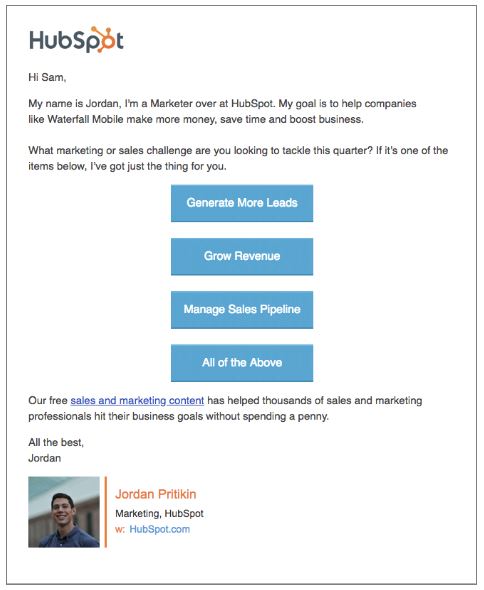
Depending on what the recipient selected, they received a follow-up message, such as:
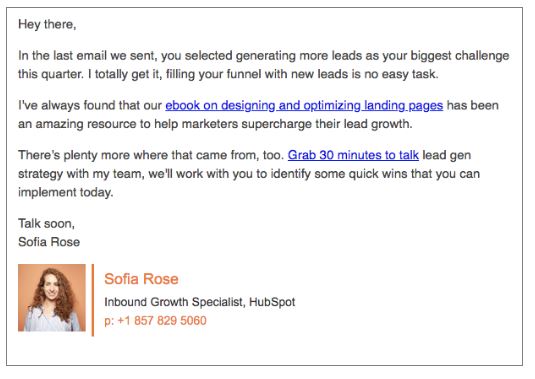
The follow-up emails continued as engagement skyrocketed, eventually leading prospects to set up a meeting with the HubSpot sales team. If they didn’t book a meeting, the workflow called for one last message:
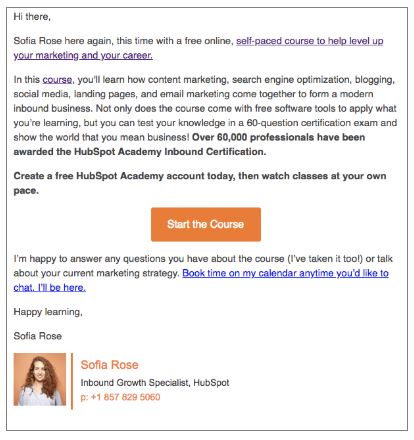
Notice how the content continued to provide the recipient with valuable content – as opposed to snubbing them just because they didn’t want to purchase HubSpot’s services at the time.
The numbers show the success of this email workflow: HubSpot saw a 67 percent open rate and 61 percent click-through rate.
The big takeaway on this one is to find the best way to truly address your audience’s challenges, serving as the hero that helps them overcome those struggles. Provide them with genuine value before closing the deal and you’re more likely to see the conversions.
Example 2: Framebridge
In the least mischievous way possible, email nurturing is about the long con. Remember that – especially at the beginning of the process – you’re building a relationship with your leads before turning them into customers.
Framebridge executes this perfectly, sending out educational emails that are easy to digest and useful for readers.

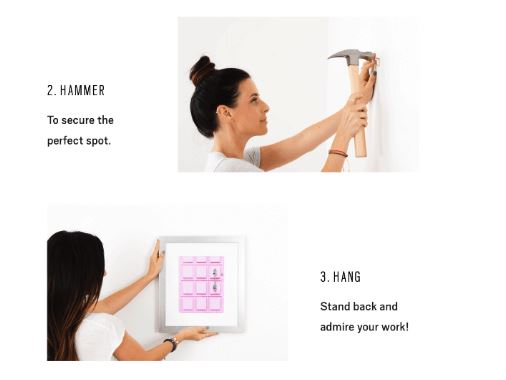
If readers are interested, they can click on the “educate me” CTA button, which takes them to a blog post explaining the steps in greater detail. Odds are they may explore the blog or website further after completing the post – building a connection to Framebridge one step at a time.
Example 3: JetBlue
Known for being one of the only brands to continually pull off puns, JetBlue no doubt uses cheeky humor in its email marketing. The airline focuses on keeping current or past customers engaged, using emails to encourage them to become TrueBlue members.

Not only is the copy super fun and engaging, but it also targets a specific segment of their audience with an effective follow-up email. JetBlue can’t survive off of flyers purchasing only one flight, so this email further serves as a reminder that the airline is at your service for your future flying needs.
Tips for winning the email nurturing game
We got up close and personal with email, but before we leave you to craft your killer lead nurturing strategy, we have some final thoughts to solidify the relationship. Here are some golden nuggets of advice to keep in mind:
- Focus on the consumer: Don’t bore them with information about your company. Instead, focus on their needs and provide them that priceless value.
- Get personal: Segment before you hit send. The more tailored the email is to the recipient, the more likely they are to engage with the content.
- Be genuine: Of course you have other motives in mind, but you’ll lose prospects if you’re too forceful with your sales pitch. It’s about education not promotion!
- Create a conversation: When possible, it’s always better to talk with your leads rather than at them.
- Don’t overload inboxes: No matter how useful your content is, don’t overwhelm your recipients with daily emails. Space them out for a better response.
- Go mobile: This is a no-brainer, but make sure your email looks great on a mobile device because that’s where a large portion of your recipients check their inboxes.
- Never stop tweaking: Today’s most effective nurturing campaign may not be tomorrow’s. Make sure you develop a flexible lead nurturing strategy that allows you to test, learn and improve.
With that, it’s time to start nurturing those leads. Good luck!





